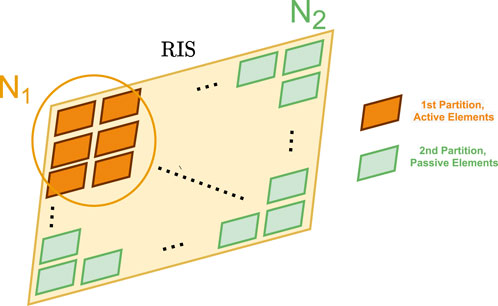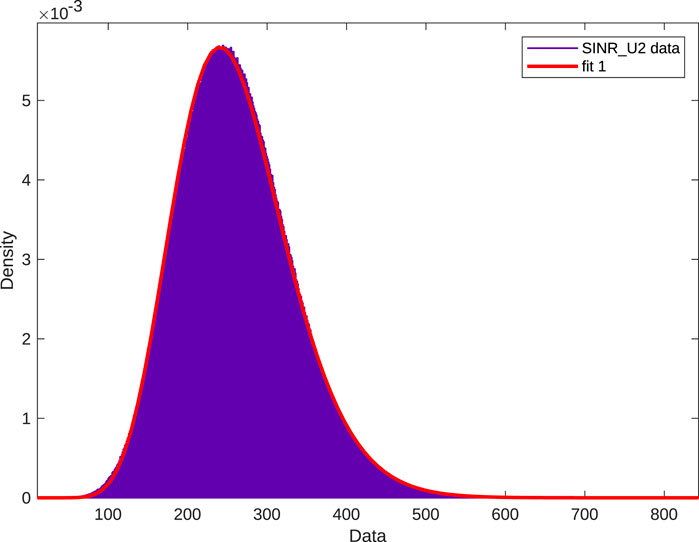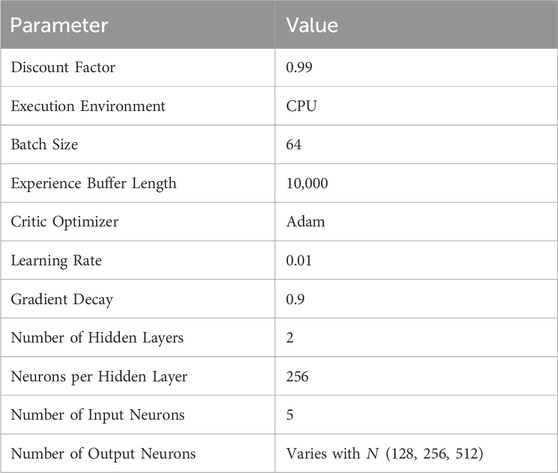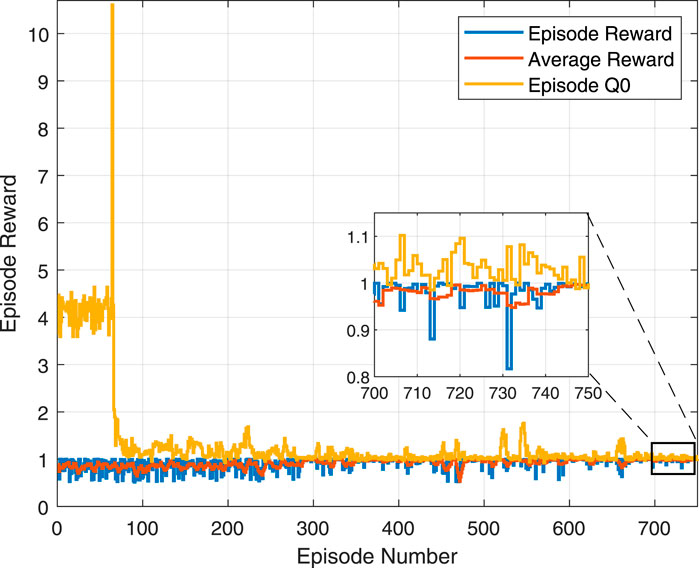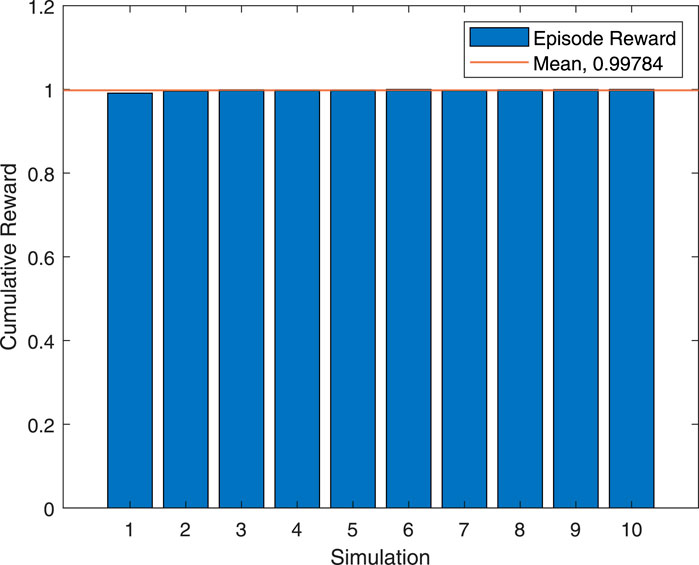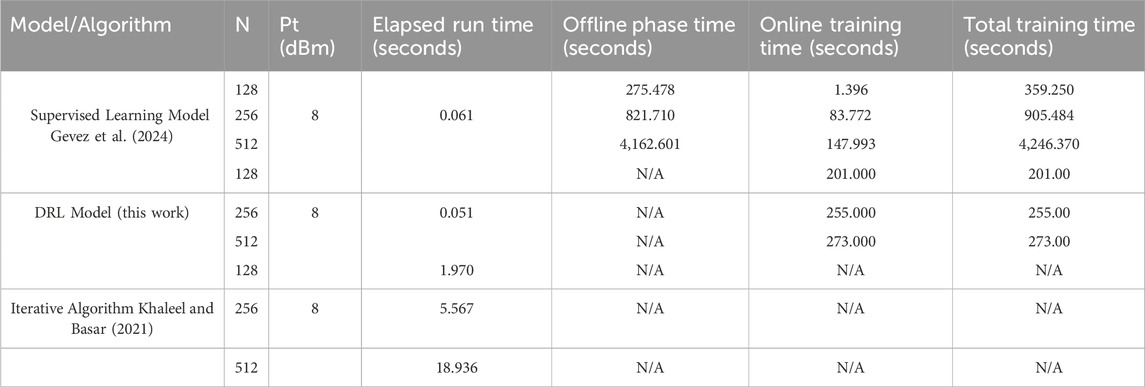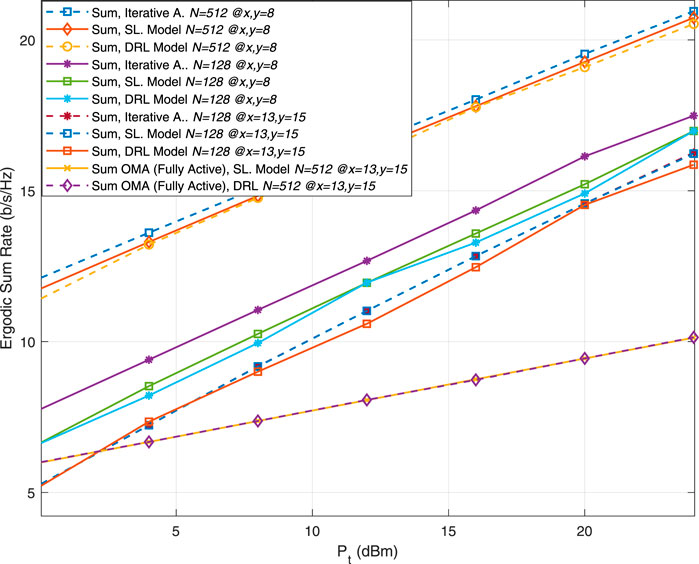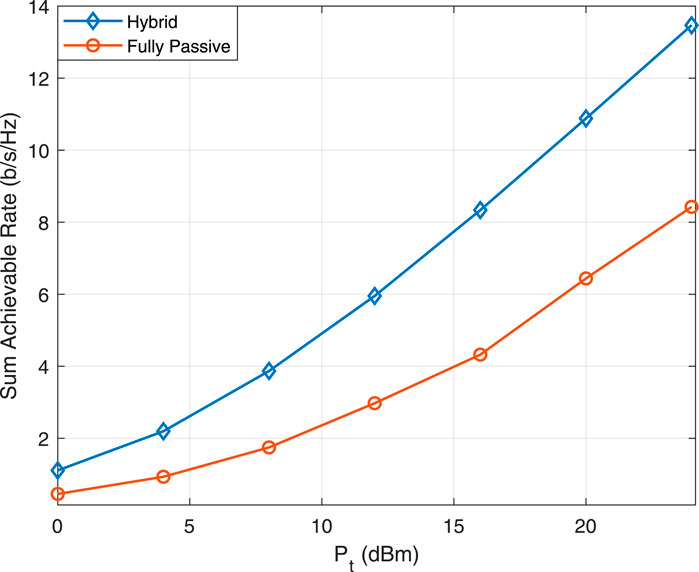- CoreLab, Department of Electrical and Electronics Engineering, Koç University, Istanbul, Türkiye
The rapid evolution of wireless communication technologies necessitates innovative solutions to meet the increasing performance requirements of future networks, particularly in terms of spectral efficiency, energy efficiency, and computational efficiency. Reconfigurable Intelligent Surfaces (RIS) and Non-Orthogonal Multiple Access (NOMA) are emerging as promising technologies to enhance wireless communication systems. This paper explores the dynamic partitioning of RIS elements in NOMA systems using Deep Reinforcement Learning (DRL) to optimize resource allocation and overall system performance. We propose a novel DRL-based framework that dynamically adjusts the partitioning of RIS elements to maximize the achievable sum rate and ensure fair resource distribution among users. Our architecture leverages the flexibility of RIS to create an intelligent radio environment, while NOMA enhances spectral efficiency. The DRL model is trained online, adapting to real-time changes in the communication environment. Empirical results demonstrate that our approach closely approximates the performance of the optimal iterative algorithm (exhaustive search) while reducing computational time by up to 90 percent. Furthermore, our method eliminates the need for an offline training phase, providing a significant advantage in dynamic environments by removing the requirement for retraining with every environmental change. These findings highlight the potential of DRL-based dynamic partitioning as a viable solution for optimizing RIS-aided NOMA systems in future wireless networks.
1 Introduction
Wireless communication has witnessed a significant transformation, from its origins with radio waves to the upcoming era of 6G technology. This progression began with basic radio communications and advanced through successive generations, each marking a leap in enhancing global connectivity. The introduction of 4G was a major advancement, delivering high-speed data transmission and setting the stage for the widespread adoption of mobile broadband. The current generation, 5G, is revolutionizing the field with its promise of very high speeds and minimal delay, enabling advancements like the Internet of Things (IoT) and the development of smart urban environments. Looking ahead, 6G is expected to further expand the horizons of connectivity and foster innovations on a large scale Giordani et al. (2020).
The constant quest for improved communication services, combined with the rapid evolution of wireless technologies, has propelled the continuous exploration and development of advanced wireless communication strategies. In this context, non-orthogonal multiple access (NOMA) has been identified as a key technology poised to enhance the efficiency of future wireless systems, thanks to its capacity to cater to distinct operational needs Makki et al. (2020). As we witness an exponential increase in global communication demands, the adoption of advanced multiple-access technologies like NOMA becomes essential.
Recently, reconfigurable intelligent surfaces (RISs) have emerged as an innovative technology in the field of advanced communication systems, offering notable advantages such as cost efficiency and the ability to create intelligent radio environments Basar et al. (2019); Liu et al. (2021). Their ability to modify the communication channel and environment in an eco-friendly and cost-effective manner has garnered significant attention, establishing RISs as a strong alternative to extensive multiple-input multiple-output (MIMO) systems and a key component in the next-generation of communication systems Khaleel and Basar (2021). RISs facilitate the modulation of signals in an energy-efficient way at a reduced cost, thereby playing a crucial role in securing and optimizing multi-user communication Huang et al. (2019).
However, the dynamic nature of wireless networks necessitates advanced strategies for the efficient allocation and partitioning of RIS elements, especially in multi-user environments. Addressing this need, Deep Reinforcement Learning (DRL) offers a promising approach by enabling systems to learn optimal partitioning strategies through interaction with the environment, without relying on predefined models or extensive offline training phases. This research builds upon our previous work Gevez et al. (2024), extending the exploration of RIS-aided NOMA systems through the application of DRL to optimize RIS partitioning for two users.
1.1 Literature review
To provide a comprehensive understanding of the significant advancements and persistent challenges in Reconfigurable Intelligent Surface (RIS)-aided NOMA systems, we review the existing literature. This review highlights key developments, innovative solutions, and areas requiring further exploration within the domain. By examining the current state of the art, we aim to identify the gaps that our research seeks to address, thereby contributing to the ongoing discourse and advancement of RIS-aided NOMA technologies.
Non-Orthogonal Multiple Access (NOMA): NOMA is primarily categorized into code-domain NOMA (CD-NOMA) and power-domain NOMA (PD-NOMA). CD-NOMA uses unique sparse spreading sequences for signal multiplexing across non-orthogonal frequency bands, effectively reducing user interference Liu and Yang (2021). Recent studies have explored new approaches in CD-NOMA to further improve spectral efficiency and reduce interference. For instance, Zhang X. et al. (2021) introduced an advanced sparse code design that significantly enhances the performance of CD-NOMA systems in dense user environments. Similarly, Kim et al. (2022) proposed a new coding scheme that improves the decoding accuracy in high-interference scenarios, making CD-NOMA more robust for practical applications.
Conversely, PD-NOMA, which enjoys more widespread application, allows the simultaneous sharing of time and frequency resources among users by differentiating signals based on their power levels Islam et al. (2017). Using successive interference cancellation (SIC), this method enables the differentiation of signals by their power intensity, allowing the coexistence of multiple users within the same non-orthogonal radio frequencies. Recent advancements in PD-NOMA have focused on optimizing power allocation strategies to enhance security and efficiency. For example, Liu J. et al. (2022) proposed a new power allocation scheme that improves the security of PD-NOMA systems against eavesdropping attacks while maintaining high spectral efficiency. Additionally, Wang T. et al. (2023) developed an adaptive power control algorithm that dynamically adjusts power levels based on real-time channel conditions, significantly improving overall system performance.
However, the traditional application of SIC in PD-NOMA requires a shared power strategy, which could inadvertently expose signals to potential security breaches. To address this, Chen Q. et al. (2023) developed an enhanced SIC mechanism that incorporates dynamic power adjustment to mitigate security risks without compromising system performance. Furthermore, Huang Y. et al. (2023) introduced a hybrid SIC approach that combines machine learning techniques with traditional SIC to predict and mitigate interference more effectively. These recent contributions highlight the continuous evolution of NOMA technologies in enhancing the efficiency, security, and robustness of wireless communication systems.
1.1.1 Reconfigurable Intelligent Surfaces (RISs)
Reconfigurable Intelligent Surfaces (RISs) have gained prominence as a cost-effective and energy-efficient solution to enhance wireless environments. Recent surveys, particularly those by Basar et al. (2023), clearly outline the development of RISs within 6G wireless communication technologies. These comprehensive reviews highlight RISs’ key advancements, showing their potential to overcome current challenges in signal efficiency, connectivity, and system performance.
Building on these insights, Wu et al. (2023) explore the integration of RIS with machine learning algorithms, showing how intelligent surfaces can adapt dynamically to changing wireless environments to optimize performance. Furthermore, Tang et al. (2022) provide an in-depth analysis of the potential of RIS to significantly enhance the capacity and reliability of wireless networks, especially in dense urban settings.
Recent studies also explore the application of RIS in millimeter-wave (mmWave) and terahertz communication systems. For example, Li et al. (2022) discuss the use of RIS to overcome the high path loss and signal blockage issues inherent in mmWave and terahertz bands, showcasing substantial improvements in signal strength and coverage. Additionally, Yang et al. (2023) investigate the deployment strategies of RIS in heterogeneous networks, highlighting their ability to facilitate seamless connectivity and robust performance in multi-tier network architectures.
Such scholarly efforts highlight RIS technology as a key development in the evolution of future wireless networks, setting a new standard for research and application in the field Basar et al. (2023); Wu et al. (2023); Tang et al. (2022); Li et al. (2022); Yang et al. (2023).
1.1.2 Machine learning (ml) in wireless communications
Machine learning (ML), particularly deep learning (DL) and DRL, has shown great potential in optimizing wireless communication systems. These approaches enable systems to learn and adapt to changing environments, enhancing performance without the need for manual configuration. For example, DL has been utilized for tasks such as user clustering, which significantly reduces computational demand and enables optimal power distribution through sequential decoding (Cui et al., 2018).
Recent advancements have further explored the integration of traditional ML models with DL techniques. Gao et al. (Mar. 2021) combined Gaussian mixture models with K-means clustering to effectively align interference and manage increasing network traffic. This hybrid approach has proven beneficial in dynamically adapting to fluctuating network conditions.
DRL has emerged as a particularly powerful tool in this domain, offering advanced methods for optimizing complex wireless communication tasks. For instance, Yang et al. (2021) applied DRL to optimize phase configurations in a NOMA framework supported by RIS, significantly enhancing spectral efficiency.
Recent studies have delved deeper into DRL’s applications in wireless communications. Wang et al. (2022) explored the use of DRL for resource allocation in heterogeneous networks, demonstrating its ability to achieve near-optimal performance with reduced computational overhead. Furthermore, Zhang et al. (2023b) investigated DRL-based dynamic spectrum access, showing substantial improvements in spectrum utilization and interference management.
Moreover, Li et al. (2023) developed a robust DRL framework to manage the inherent uncertainties in wireless environments, enhancing the reliability and efficiency of communication systems. Additionally, Sun et al. (2023) proposed a multi-agent DRL approach for cooperative spectrum sharing, which significantly improves network throughput and reduces latency.
Recent research by Chen R. et al. (2023) focused on DRL for real-time beamforming in massive multiple-input multiple-output (MIMO) systems, achieving notable gains in energy efficiency and signal quality. Another study by Huang L. et al. (2023) introduced a joint DRL framework for simultaneous optimization of power allocation and interference management in ultra-dense networks.
These advancements highlight the important role of ML, particularly DRL, in evolving next-generation wireless communication systems, driving significant improvements in efficiency, adaptability, and overall performance.
1.1.3 RIS-NOMA Integration
The study of different phase adjustment strategies in RIS-aided NOMA systems reveals a balance among reliability and system complexity, proposing a simplified phase selection method for random phase shifting to improve signal reception Ding et al. (2020). Recent research by Chen et al. (2021) further explores optimized phase adjustment algorithms, demonstrating substantial improvements in signal reception and overall system performance.
Furthermore, a partitioning algorithm designed to boost spectrum efficiency by improving the ergodic rate for all users, while ensuring fairness, has been put forward Khaleel and Basar (2022). Recent advancements by Zhao et al. (2022) have refined this algorithm, enhancing spectrum efficiency and user fairness in more dynamic network environments.
Additionally, a new simultaneously transmitting and reflecting (STAR)-RIS-aided NOMA scheme has been introduced. This scheme utilizes the unique capabilities of STAR-RIS to manage incident signals by either transmitting or reflecting them, thus integrating a NOMA framework to cater to diverse user needs through innovative signal management Zuo et al. (2021). Building on this, Zhang et al. (2023a) presented an advanced STAR-RIS design that further optimizes the balance between transmission and reflection, achieving higher spectral efficiency and better user experience.
Recent studies have also focused on integrating ML techniques with RIS-NOMA systems. Wang X. et al. (2023) proposed a ML-based optimization framework for RIS-NOMA, which dynamically adjusts system parameters to maximize performance. Another significant contribution is from Xu et al. (2023b), who introduced an adaptive ML-based framework for optimizing the placement and configuration of RIS in NOMA systems, achieving improved performance metrics in terms of both throughput and latency. This approach has shown significant potential in enhancing system adaptability and efficiency.
In conclusion, the integration of ML techniques with RIS-NOMA systems represents a significant advancement in the field of wireless communications. By leveraging the adaptability and efficiency of ML algorithms, these systems can dynamically optimize parameters to improve performance, spectral efficiency, and energy consumption. The continuous evolution of RIS-NOMA integration, driven by innovative ML-aided approaches, promises to significantly enhance the capabilities and robustness of future wireless communication networks.
1.2 Motivation
Integrating NOMA with RIS presents a promising solution to address the limitations of traditional communication systems, such as increased processing times. Despite these efforts, traditional allocation approaches face challenges, especially in large-scale systems, where they can lead to increased processing times. Our preceding research Gevez et al. (2024) ventured into a novel technique for distributing RIS elements, harnessing supervised learning to refine the partitioning of RIS and mitigate interference among users in non-line-of-sight (NLOS) scenarios. This initiative represents a significant step towards optimizing communication systems for the future, ensuring more efficient and effective utilization of RIS in enhancing wireless connectivity.
Building on our previous work, which utilized supervised learning for RIS partitioning, this study introduces a novel DRL-based framework. Our approach dynamically adjusts RIS partitioning to optimize resource allocation and enhance system performance. The proposed framework significantly improves upon previous methodologies by eliminating the offline training phase, thus enhancing adaptability to real-time network changes.
The enhancements detailed in this work are rooted in a deep understanding of the dynamic nature of wireless networks and the critical role of RIS in maximizing NOMA system performance. The contributions of our current study are characterized by several key advancements:
Table 1 contextualizes our work within the landscape of machine-learning-assisted RIS-aided NOMA literature focusing on sum rate optimization. Gevez et al (2024) used supervised learning for RIS partitioning, achieving significant improvements but requiring extensive offline training. Yang et al (2021) applied deep reinforcement learning (DRL) for phase configuration, yielding moderate gains with complex implementation. Gao et al (Mar. 2021) used K-means clustering for interference management, resulting in high sum rate gains but facing scalability issues. Recent works such as Amin et al (2023) employed DRL for energy-efficient resource allocation, achieving moderate improvements but with centralized control limitations. Additionally, Guo et al (2023) investigated DRL for resource allocation in device-to-device (D2D) communication, showing high sum rate improvements in a multi-RIS environment. Xu et al (2024) explored DRL for secure mobile edge computing, achieving moderate improvements with a focus on security enhancement. Our work, using the DRL-based dynamic RIS partitioning, achieves near-optimal sum rate improvements without the need for offline training, providing significant real-time adaptability advantages over traditional methods.
The results indicate that our DRL-based approach achieves near-optimal sum rate improvements without the need for offline training, providing significant real-time adaptability advantages over traditional methods. This study enhances the understanding of the applicability and effectiveness of DRL in optimizing RIS-aided NOMA systems, setting a new benchmark for future research and practical implementations.
Our work employs a Deep Q-Network (DQN) for dynamic RIS partitioning, achieving near-optimal sum rate improvements without the need for offline training. This real-time adaptability is crucial for dynamic environments. Unlike other studies, our approach eliminates the offline training phase, enhancing practical deployment.
In summary, this paper addresses a crucial aspect of enhancing RIS-aided NOMA systems and represents an improvement over our previous contributions. By focusing on the dynamic and efficient partitioning of RIS elements through DRL, we present a model that combines theoretical innovation with practical applicability, setting a new standard for the deployment and operation of advanced wireless communication systems.
By addressing the limitations of previous methods and providing a scalable, efficient solution, our research significantly advances the field of RIS-aided NOMA systems. This study enhances sum rate and fairness and ensures adaptability to changing network conditions, positioning our work as a substantial contribution to the literature.
This paper is organized as follows: Section 1 delves into the system model, detailing the architecture and key components of our uplink-NOMA communication setup. Section 2 provides an analytical analysis of outage probability, establishing a theoretical framework for assessing system reliability. In Section 3, we introduce our novel DRL scheme, discussing its methodology, strategy, and the unique benefits it offers for dynamic RIS partitioning. Section 4 presents numerical results derived from comprehensive simulations, showcasing the effectiveness of our DRL-based approach in comparison to traditional methods. We conclude in Section 5 with a discussion on the implications of our findings for the future of wireless communication systems, emphasizing the advancements made through the application of DRL in optimizing RIS-aided NOMA systems. Throughout, we highlight our contributions to the field and suggest directions for future research.
2 System model
In this part of our study, we introduce the architecture of our uplink-NOMA communication setup, which includes transmissions from two single-antenna users to a single-antenna Base Station (BS). This model operates within a quasi-static, frequency-flat Rayleigh fading channel environment. Rayleigh fading is chosen in this work because it effectively models the multipath propagation effects encountered in Non-Line-of-Sight (NLOS) outdoor environments, such as those found in sporting events. This makes it particularly suitable for evaluating the performance of wireless communication systems in realistic, dynamic environments like outdoor sports venues Goldsmith (2005).
The scenario is set within a two-dimensional, 20 m by 20 m outdoor area, with both users located at ground level, as illustrated in Figure 1. While the RIS and the first user (U-1) are fixed in position, the second user (U-2) has the liberty to move around a predefined zone. Information about deployment positions and their corresponding RIS partitioning schemes are stored in a dedicated database.
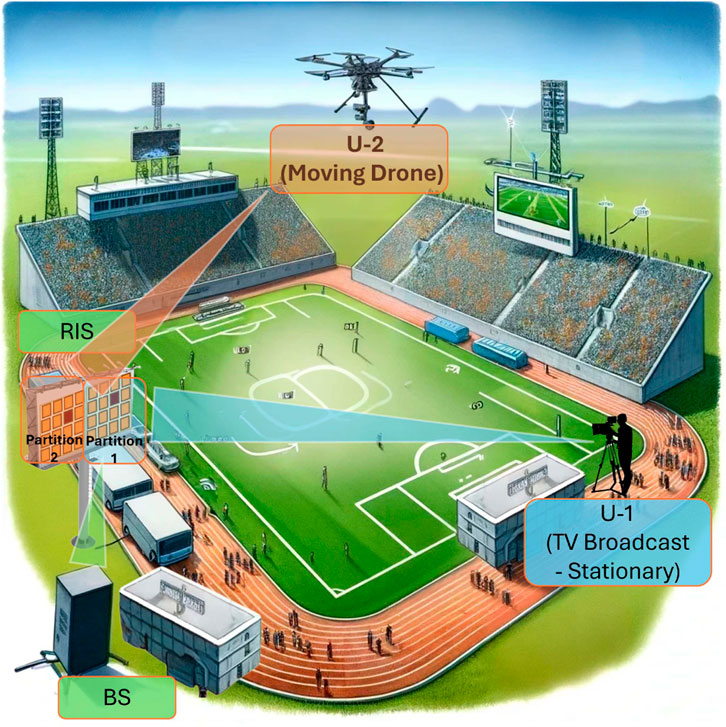
Figure 1. System scheme for a two-user uplink scenario in an outdoor environment. (This figure is generated using AI.)
To illustrate a practical example of an outdoor scenario involving one static and one mobile user with a partitioned RIS, consider an outdoor sporting event. In this scenario, a static broadcasting unit (U-1) is stationed at a fixed location to manage real-time event coverage and communication with the central BS. Simultaneously, a mobile user (U-2), such as a camera drone, navigates the event area to capture and stream live footage. The RIS is strategically partitioned into two sections to dynamically optimize the signal reflection towards both the static and mobile users. This setup demonstrates the applicability of our model in real-world dynamic environments, where the RIS can adaptively enhance communication performance for both fixed and moving entities, ensuring robust and efficient data transmission. To determine the precise locations for U-2’s various points, sophisticated positioning techniques are employed, following the guidance of references such as Witrisal et al. (2016).
Despite the practical challenges in obtaining perfect Channel State Information (CSI), it remains a common assumption in studies concerning RIS-aided NOMA, including notable references like Zhang et al. (2022); Liu Y. et al. (2022); Zhang Z. et al. (2021). The acquisition of CSI is assumed to be feasible through methodologies proposed in literature, notably Wei et al. (2021) and Noh et al. (2022). Our communication process transmits single-carrier signals from users to the BS via a single hybrid-RIS. The RIS comprises
A DRL model is harnessed to find the best partitioning strategy that optimizes both the network throughput and fairness among users. For baseline comparison, the optimal iterative algorithm for dynamic RIS partitioning, as detailed in Khaleel and Basar (2022), employs an exhaustive search method to find the best allocation of RIS elements. This method systematically evaluates all possible partitioning configurations to maximize the sum rate and ensure fairness among users. While this approach guarantees finding the optimal solution, it is computationally intensive and time-consuming, especially as the number of RIS elements increases. With precise CSI, the RIS is adeptly configured, aligning
In consideration of these factors, the signal that is received at the BS can be described in Eq. 1 as follows:
Here,
A user benefiting from both coherent alignment and amplification exhibits significantly greater strength compared to another user coherently aligned without amplification, as seen in the scenario where the passive side supports the user. Thus, the SINR for the first and the second user is given in Eq. 2, which is at the top of this page.
In light of the SINR calculations obtained, the data transmission rate for the
3 Analytical analysis of outage probability
This section presents an analytical exploration of the outage probability to validate the reliability of outcomes obtained from parametric simulations. Leveraging the central limit theorem—which posits that the average of a large number of samples approximates a normal distribution—it can be deduced that with a substantial number of reflective elements, the cumulative channel effects tend towards a Gaussian distribution. For notational ease, we transform parts of the SINR formula by introducing auxiliary variables such as
The adaptation of SINRs for user U-2 to a Gamma distribution, as depicted in Figure 3 with the reflective element count at 128 and the transmission power
The Gamma distribution’s parameters, namely, the shape
We particularly examine U-2, which is serviced by the passive component of the RIS. The outage probability
where
where
substituting
where
4 Deep reinforcement learning scheme
In our system model, we incorporate a dynamic DRL approach tailored for real-time application. This DRL model is specifically designed to conduct online partitioning of the RIS, enabling the system to adapt instantaneously to variations in the communication environment. Unlike traditional methods that rely on offline training and static partitioning strategies, our model leverages the inherent adaptability of DRL to assess and modify the RIS configuration on the fly. This online partitioning is crucial for operational efficiency, particularly in scenarios where user positions and channel conditions are subject to frequent changes. By employing online partitioning, our DRL model ensures that the RIS can dynamically adjust the allocation of its reflecting elements to users, thereby optimizing the signal reflection properties in real time and maintaining the robustness of the NOMA communication system.
This model’s online partitioning capability is essential for maintaining operational efficiency in scenarios marked by continuous changes in user positions and channel conditions. It ensures that the RIS can dynamically adjust its reflecting elements across users, optimizing signal reflection properties in real time and upholding the integrity of the NOMA system’s functionality.
A key aspect of our DRL model is its ability to match the performance of iterative algorithms and supervised learning schemes in configuring RIS partitioning while reducing computational complexity and operational time. This efficiency does not come at the expense of significantly outperforming these conventional methods in metrics such as fairness or total sum rate; rather, the DRL framework achieves a performance level on par with these methodologies, supplemented by the critical advantages of enhanced real-time adaptability. This efficiency and adaptability represent an important advancement in operational efficiency and computational economy.
The model makes achieving optimal partitioning strategies not just a theoretical possibility but a practical reality, streamlined and viable within the stringent demands of dynamic system environments. By reducing computational demands with the capacity for real-time system adaptation, our DRL approach manages the trade-offs between performance, efficiency, and complexity.
4.1 DRL strategy
DRL is an advanced machine learning approach that combines artificial neural networks with a reinforcement learning architecture. This enables autonomous agents to learn optimal behaviors within complex environments by interacting with the environment, observing the outcomes of their actions, and adapting their strategies to maximize a numerical reward signal. At the core of DRL is the agent-environment interaction, where the agent performs actions, and the environment responds with new states and rewards as depicted in Figure 4. These components are mathematically formulated as the state space, action space, and reward function.
Implemented within the MATLAB Deep Learning Toolbox The MathWorks, Inc (2023), DRL utilizes MATLAB’s computational tools to streamline the development and training of neural networks that approximate the policy and value functions—the central mechanisms by which the agent assesses its current policy and estimates the expected outcomes of its actions. The toolbox provides a framework for defining the problem’s specific DRL components, such as custom observation and action spaces, and for integrating them with neural network layers and training algorithms. By using these tools, it is possible to efficiently construct and train DRL agents for a wide array of applications, leveraging MATLAB’s optimization routines and GPU-accelerated computing capabilities to handle the extensive computations involved in the training process.
The environment in DRL is modeled as a Markov Decision Process (MDP), where the transition between states is determined by the actions of the agent. The state is represented as a multi-dimensional array or a custom data structure that reflects the agent’s perception of the environment. A well-designed state representation is crucial for the agent’s ability to learn the optimal policy. When the agent selects an action based on its policy, the environment reacts by transitioning to a new state and returning a reward. This reward is a scalar value that signals the agent about the effectiveness of the action. MATLAB’s toolbox facilitates the definition of this action-reaction mechanism, allowing the simulation of the environment’s dynamics through the step function in our environment. The step function contains all wireless communication configurations of our scenario defined in Section 2.
In this study, we selected the DQN algorithm with two hidden layers each with 256 hidden units to address the dynamic partitioning of RIS elements in NOMA systems. The DQN algorithm is well-suited for environments with discrete action spaces, which align with the nature of RIS element partitioning tasks. Unlike algorithms such as Deep Deterministic Policy Gradient (DDPG), which are designed for continuous action spaces, DQN efficiently handles the discrete decision-making required in our context Lillicrap et al. (2015). DQN is known for its high sample efficiency, meaning it can learn effective policies with fewer interactions with the environment.
This efficiency is crucial for our application, where the cost of environment interactions can be high in terms of time and computational resources. The DQN algorithm has demonstrated stability and reliable convergence properties in various applications Mnih et al. (2015). This stability is essential for ensuring that the DRL model can consistently find near-optimal solutions for RIS partitioning without significant fluctuations or instability during training. Preliminary experiments and literature review indicated that DQN performs well in scenarios similar to ours Hessel et al. (2018). The empirical evidence supports its ability to achieve high performance in terms of maximizing the sum rate and ensuring fair resource allocation among users.
4.1.1 State Space
The state space
where
4.1.2 Action Space
To navigate through
where
4.1.3 Reward Function
The reward function
where
where the index is a calculated metric of fairness based on the users’ data rates. This incentivizes not only throughput maximization but also the sustenance of fairness across the NOMA landscape.
The DRL agent employs a policy network parameterized by weights
4.1.4 Policy Optimization
The learning process aims to find the optimal policy, mathematically modeled as a gradient ascent on expected rewards which is presented in Eq. 14 as follows:
where
Empirical simulations corroborate the DRL scheme’s effectiveness, showcasing its capability to swiftly adapt to environmental changes while fostering fairness among the users. Through this adaptive mechanism, we achieve a balance between system responsiveness and operational integrity, demonstrating the viability of DRL in managing the demands of RIS-aided NOMA systems.
5 Simulation results
In this section, we present the results of our computer simulations aimed at evaluating the effectiveness of DRL-based partitioning within the established uplink NOMA communication system framework. This study extends our communication model to incorporate DRL as the principal mechanism for partitioning RIS, diverging from traditional approaches. Our analysis compares the DRL-based partitioning strategy against an iterative algorithm and the supervised learning-based method detailed in the literature.
The simulations are conducted at an operational frequency of 1.8 GHz, representative of sub-6 GHz frequencies commonly used in current wireless communication systems. The choice of reflective elements for the RIS (
Our simulation methodology employs
Our neural network within the DRL model employs a multi-layered neural network characterized by fully connected layers designed to process an input with five distinct features. The network architecture is composed of two hidden layers, each consisting of 256 neurons, with rectified linear unit (ReLU) activation functions facilitating the introduction of non-linearity, enabling the model to capture complex relationships within the data. In our neural network design, the input layer comprises three neurons, each representing the transmit power, the number of reflecting elements, and the distance in meters. The output layer consists of a single neuron, corresponding to the one-dimensional action space in our reinforcement learning framework. This output neuron determines the number of reflecting elements required for a single user. Consequently, the number of elements allocated to the other user is simply the total number of reflecting elements minus the number allocated to the first user. This framework is versatile and can be applied to any RIS design with varying numbers of reflecting elements and transmit power levels. This configuration results in a total of approximately 100.2K learnable parameters, encompassing the weights and biases across all layers, which are iteratively adjusted during the training process. The sequential composition of these layers forms a robust framework for the DRL algorithm to dynamically optimize the partitioning of RIS elements between two users in a NOMA system, with the network’s depth and breadth calibrated to capture the intricacies of the wireless environment and user interactions.
Table 2 presents the parameters and hyperparameters used for the DRL simulation employing the DQN algorithm. The agent options include a discount factor of 0.99, which ensures future rewards are appropriately weighted, aiding in the long-term optimization of the system. The execution environment is set to CPU, providing a balance between computational efficiency and resource availability. A batch size of 64 is chosen to stabilize the learning process, while an experience buffer length of 10,000 allows the agent to learn from a diverse set of past experiences, enhancing the robustness of the policy.
The critic optimizer utilizes the Adam optimizer with a learning rate of 0.01, which facilitates efficient and adaptive learning rates during training. The gradient decay of 0.9 helps in maintaining the momentum of gradients, preventing oscillations and aiding in faster convergence. The neural network consists of 256 hidden neurons per layer, providing sufficient capacity to model complex relationships in the data, which is crucial for accurately approximating the Q-values in the DQN algorithm. These carefully chosen parameters collectively ensure that the DRL model is both efficient and effective, optimizing the RIS partitioning strategy to improve system performance.Figure 5 illustrates the progression of the episodic reward over time through 750 episodes of partitioning training using the DRL framework for the RIS with 128 reflecting elements. Notably, there is significant variance in the early episodes, where a peak is observed, indicating a possible exploration of the action space or initial adjustments of the model’s parameters. As training progresses, the reward stabilizes, demonstrating the model’s convergence towards an optimal policy. The trend shows a clear decrease in variability and an increase in the consistency of the episodic reward, suggesting that the DRL model is learning effectively over time.
JFI, which ranges from 0 to 1, is a key component of the reward function to ensure fair resource allocation among users. During the initial exploration phase of the DRL algorithm (episode Q0), the agent explores various actions to learn the environment and understand the impact of different RIS partitioning strategies. The high reward values observed in this phase, though seemingly exceeding 1, result from an additional scaling factor applied to the JFI or from cumulative rewards over multiple steps, not from JFI alone. This exploration can sometimes yield high cumulative rewards, indicating that the agent has identified potentially optimal actions early in the training process.
Higher reward values are better as they signify better system performance in terms of sum rate and fairness. As training progresses, the agent shifts from exploration to exploitation, focusing on actions that consistently yield higher rewards, ensuring the agent converges towards an optimal strategy that maximizes the system’s performance. In summary, the episode reward values for episode Q0 indicate the potential of the agent to find effective actions early on, possibly due to cumulative rewards or scaling factors. As training progresses, the reward values stabilize, guiding the agent towards an optimal solution, aligning with the objectives of our DRL framework.
In Figure 6, the cumulative rewards over ten separate simulations for the same RIS configuration are depicted as uniform bars with a dashed line indicating the mean of the episodic rewards. The small error bars suggest low variance, which is indicative of consistent performance across these simulations. The consistency here confirms the reliability of the DRL approach under various initial conditions, showing the model’s robustness.
The training performance metrics from the MATLAB Deep Learning Toolbox provide further insight into the effectiveness of the learning session. An episodic reward of 0.9887, very close to the average reward of 0.98842, indicates that the agent is performing at a stable level by the end of the training session. The Episode Q0 value, standing at 1.013, is particularly noteworthy. The “Episode Q0 value” refers to the initial Q-value at the start of an episode in reinforcement learning, which quantifies the expected returns (rewards) from taking the best possible action in the initial state of the episode. It is a reflection of the quality of the state-action values being learned, suggesting that the agent has developed a strong prediction capability for expected returns. This means that right from the beginning of an episode, the agent is well-informed about the potential rewards of its actions, demonstrating an effective learning and decision-making process.
Collectively, these results and training metrics underscore a successful training session, where the DRL model demonstrates both convergence to an effective policy and stability across multiple simulations, with performance metrics confirming the agent’s capacity to learn and predict the optimal actions within the defined environment.
Table 3 provides a detailed comparison of the time efficiency associated with different partitioning strategies for a RIS-NOMA communication system, specifically comparing a supervised learning model, a DRL Model, and an Iterative Algorithm across three scenarios characterized by varying numbers of RIS elements (
For the supervised learning model, the offline phase time increases with the number of RIS elements: 275.478 s for
In contrast, the DRL Model bypasses the traditional offline phase entirely, indicating an inherent efficiency in adapting to system changes dynamically. This model exhibits online training times of 201 s for
The Iterative Algorithm, while not directly comparable due to its different operational paradigm (lacking a distinct offline training phase and online training time), shows elapsed run times that increase with the number of RIS elements, from 1.969,608 s for
This comparison elucidates the substantial time efficiency advantages offered by the DRL Model, particularly in the context of offline phase reduction. Such efficiency not only enhances the model’s practical applicability but also positions DRL as a superior method for managing the complexities associated with optimizing RIS partitioning in high-dimensional communication systems. The DRL Model’s ability to operate without the need for an extensive offline phase underscores its potential for real-time adaptive system optimization, setting a new benchmark for performance and efficiency in RIS-NOMA system management.
The analysis begins with an evaluation of the ergodic sum rate across various transmit power levels
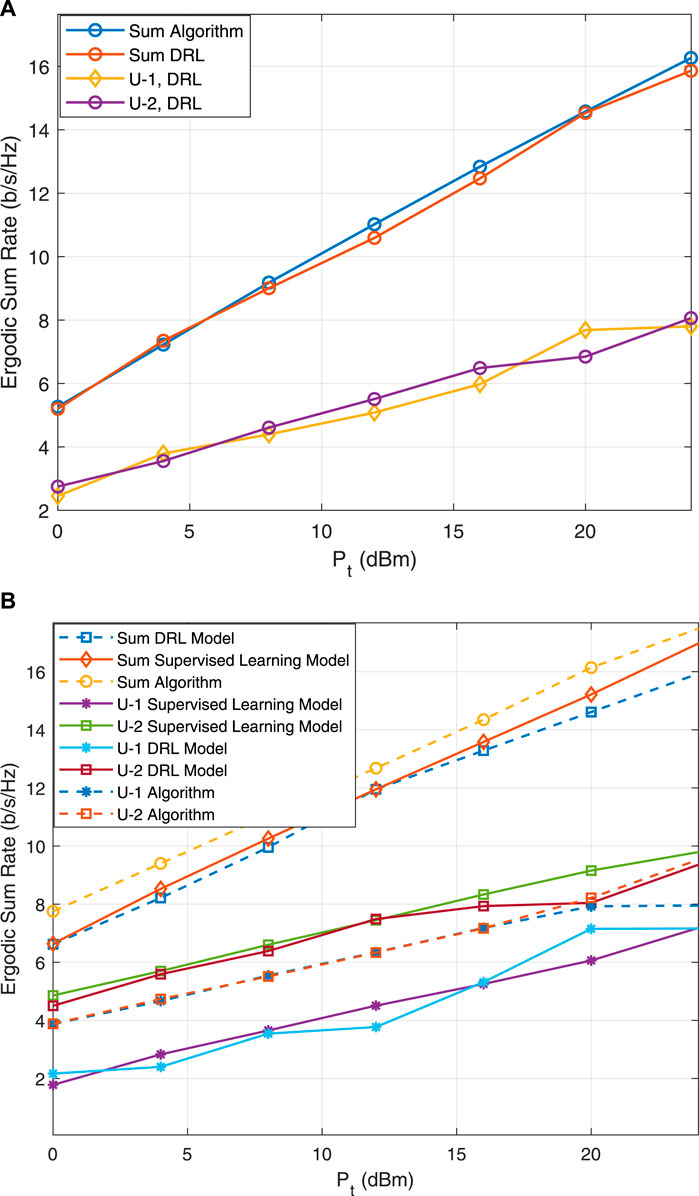
Figure 7. Comparison of achievable user rates and overall ergodic sum rates using the trained DRL model versus an iterative algorithm. Analysis includes U-2 (A) within the training area (U-2 at
Progressing to Figure 8, the DRL model’s robustness and scalability are demonstrated through its performance across diverse system configurations. An enhancement in sum rate performance is observed with an increase in training point coordinates—from the initial position at
In the environment of Orthogonal Multiple Access (OMA) systems, the findings suggest that DRL models can match with Supervised Model especially as the number of reflecting elements is increased, which is of particular relevance in scenarios where OMA is employed and labeled data may not be readily available. The consistently upward trend in sum rate with increasing transmission power
In Figure 9, the discourse transitions to an examination of the sum achievable rate for varying
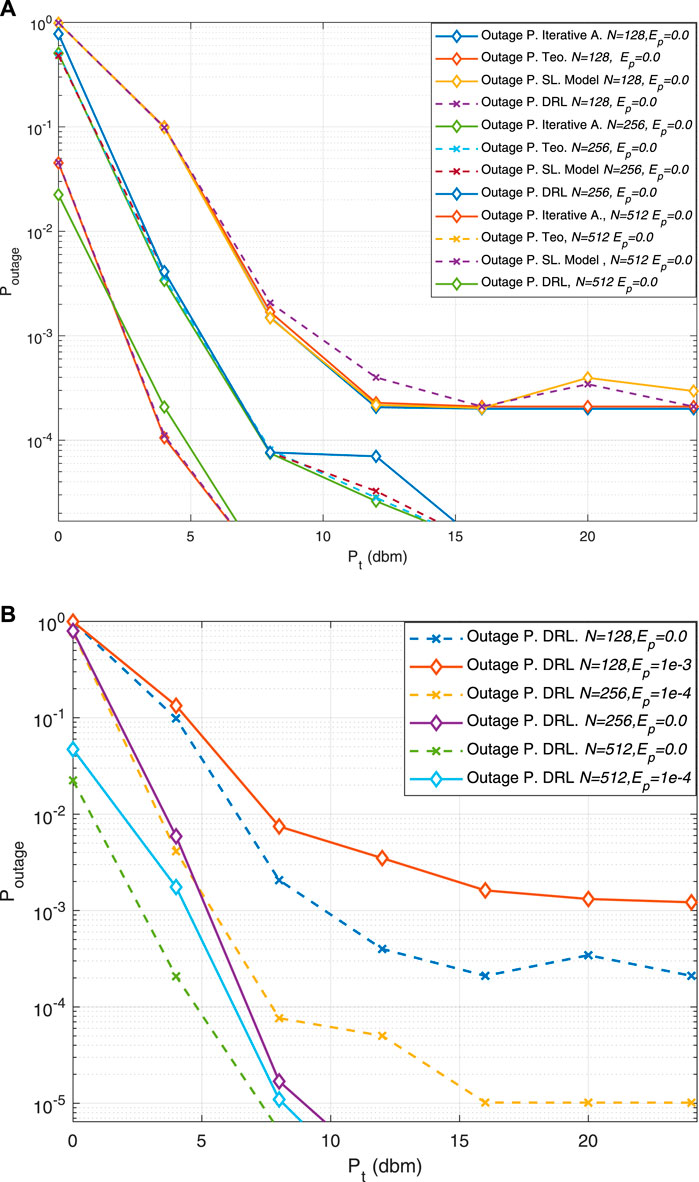
Figure 10. Comparative analysis of outage probability for U-2 utilizing the trained model versus an iterative algorithm, under diverse Quality of Service (QoS) requirements and sizes of RIS. The comparison contemplates: (A) scenarios with perfect SIC, and (B) scenarios accounting for errors in SIC
Figure 10B extends the analysis into a realistic domain where SIC is imperfect, manifesting a slight divergence from the theoretical ideal. Despite this, the DRL model demonstrates resilience by approximating the performance of the supervised learning model, signifying its robustness and adaptability in complex environments.
Moreover, Figure 10 illustrates the comparison between the theoretical outage probability, derived from our mathematical analysis in Section 3, and the empirical results obtained from the DRL-based and iterative algorithms. The relevance of the mathematical analysis of the outage probability in Section 3 is paramount as it provides a foundational framework that validates our empirical findings. By leveraging the central limit theorem to approximate the cumulative channel effects towards a Gaussian distribution, we establish a robust theoretical basis for assessing SINR under various conditions.
The theoretical curves shown in Figure 10 align closely with the empirical data, particularly under ideal conditions (perfect SIC). This close alignment demonstrates the robustness of our theoretical framework and its ability to predict system performance accurately. The DRL model’s performance, which closely matches the theoretical predictions, underscores its efficacy in achieving near-optimal outage probabilities even in practical scenarios.
Overall, the comparative analysis between the theoretical expectations and the empirical results obtained from the DRL and supervised learning models, as depicted in Figure 10, provides compelling evidence of the DRL model’s potential to revolutionize future communication systems. The DRL model’s ability to approach the supervised learning model under both perfect and imperfect SIC conditions establishes it as a promising paradigm for ensuring communication reliability in the face of operational challenges.
Our results indicate that while DRL significantly reduces overall computational and time complexities, its online training time is substantially higher than that of supervised learning approaches, presenting a trade-off between real-time adaptability and training duration. For instance, the online training time for DRL is 201 s for
While our proposed DRL-based dynamic RIS partitioning framework shows significant promise, several limitations should be acknowledged. The assumption of perfect CSI is common but challenging to achieve in practice, and any imperfections can affect performance. Additionally, the scalability of our model to larger systems with multiple users and RIS elements remains an area for further investigation, as increased complexity could impact efficiency. Furthermore, although the framework eliminates the offline training phase, the online training time required, particularly in dynamic environments, may pose constraints on real-time applicability. Addressing these limitations through advanced DRL algorithms, robust methods for handling imperfect CSI, and real-world implementations will be essential for the practical deployment and success of DRL-based dynamic RIS partitioning in future wireless communication networks.
6 Conclusion
In this paper, we have presented a novel DRL scheme to optimize the performance of RIS-aided NOMA systems. This scheme not only offers a dynamic and efficient approach to closely approximate the performance of optimal iterative algorithms but also significantly reduces computational and time complexities. By eliminating the offline training phase—a major limitation identified in our previous work on supervised learning—we have successfully demonstrated the potential of DRL in enhancing the real-time adaptability of RIS configurations to changing environments and user demands. The proposed DRL framework marks a significant step forward in the practical application and deployment of RIS-aided communication systems, potentially transforming future wireless networks with its robustness and responsiveness to the evolving communication landscape.
Data availability statement
The original contributions presented in the study are included in the article/Supplementary Material, further inquiries can be directed to the corresponding author.
Author contributions
YG: Writing–original draft, Writing–review and editing. YT: Writing–original draft, Writing–review and editing. EB: Writing–review and editing.
Funding
The author(s) declare that financial support was received for the research, authorship, and/or publication of this article. This study is supported by The Scientific and Technological Research Council of Turkey (TUBITAK) through the 2247-A National Leader Researchers Program (Project Number: 121C254), Project Titled: “Deep Learning Based Novel Next Generation Communication Systems.”
Acknowledgments
The authors acknowledge the use of OpenAI’s generative AI technologies, ChatGPT (version GPT-4o) and DALL-E (version DALL-E 2), in Figure 1.
Conflict of interest
The authors declare that the research was conducted in the absence of any commercial or financial relationships that could be construed as a potential conflict of interest.
The author(s) declared that they were an editorial board member of Frontiers, at the time of submission. This had no impact on the peer review process and the final decision.
Publisher’s note
All claims expressed in this article are solely those of the authors and do not necessarily represent those of their affiliated organizations, or those of the publisher, the editors and the reviewers. Any product that may be evaluated in this article, or claim that may be made by its manufacturer, is not guaranteed or endorsed by the publisher.
References
Amin, S., Sheikh, J., and Malik, B. (2023). A deep reinforcement learning for energy efficient resource allocation intelligent reflecting surface (irs) driven non-orthogonal multiple access (noma). Phys. Commun. 56, 101151. doi:10.1016/j.phycom.2023.102148
Basar, E., Alexandropoulos, G. C., Liu, Y., Wu, Q., Jin, S., Yuen, C., et al. (2023). Reconfigurable intelligent surfaces for 6g:Guo emerging hardware architectures, applications, and open challenges. arXiv Prepr. arXiv:2312.16874. doi:10.48550/arXiv.2312.16874
Basar, E., Di Renzo, M., De Rosny, J., Debbah, M., Alouini, M.-S., and Zhang, R. (2019). Wireless communications through reconfigurable intelligent surfaces. IEEE Access 7, 116753–116773. doi:10.1109/access.2019.2935192
Chen, J., Ma, X., and Zhang, L. (2021). Optimized phase adjustment for enhanced performance in ris-noma systems. IEEE Trans. Wirel. Commun. 20, 5205–5218. doi:10.1109/TWC.2021.3076231
Chen, Q., Zhang, L., and Sun, S. (2023a). Enhanced successive interference cancellation for secure pd-noma. IEEE Commun. Lett. 27, 89–93. doi:10.1109/LCOMM.2023.3234567
Chen, R., Zhang, X., and Li, Y. (2023b). Deep reinforcement learning for real-time beamforming in massive mimo systems. IEEE Trans. Wirel. Commun. 22, 3456–3469. doi:10.1109/TWC.2023.3187621
Cui, J., Ding, Z., Fan, P., and Al-Dhahir, N. (2018). Unsupervised machine learning-based user clustering in millimeter-wave-NOMA systems. IEEE Trans. Wirel. Commun. 17, 7425–7440. doi:10.1109/twc.2018.2867180
Ding, Z., Lv, L., Fang, F., Dobre, O. A., Karagiannidis, G. K., Al-Dhahir, N., et al. (2022). A state-of-the-art survey on reconfigurable intelligent surface-assisted non-orthogonal multiple access networks. Proc. IEEE 110, 1358–1379. doi:10.1109/jproc.2022.3174140
Ding, Z., Schober, R., and Poor, H. V. (2020). On the impact of phase shifting designs on IRS-NOMA. IEEE Wirel. Commun. Lett. 9, 1596–1600. doi:10.1109/lwc.2020.2991116
Gao, X., Liu, Y., Liu, X., and Song, L. (2021). Machine learning empowered resource allocation in IRS aided MISO-NOMA networks. ArXiv. doi:10.1109/TWC.2021.3122409
Gevez, Y., Arslan, E., and Basar, E. (2024). A supervised learning-assisted partitioning solution for ris-aided noma systems. IEEE Trans. Cognitive Commun. Netw., 1. doi:10.1109/tccn.2024.3373637
Giordani, M., Polese, M., Mezzavilla, M., Rangan, S., and Zorzi, M. (2020). Toward 6G networks: use cases and technologies. IEEE Commun. Mag. 58, 55–61. doi:10.1109/mcom.001.1900411
Guo, L., Jia, J., Zou, Y., Chen, J., Yang, L., and Wang, X. (2023). Resource allocation for multiple riss assisted noma empowered d2d communication: a mamp-dqn approach. Ad Hoc Netw. 138, 103083. doi:10.1016/j.adhoc.2023.103163
Hessel, M., Modayil, J., Van Hasselt, H., Schaul, T., Ostrovski, G., Dabney, W., et al. (2018). “Rainbow: combining improvements in deep reinforcement learning,” in Proceedings of the AAAI conference on artificial intelligence, USA, February 20–27, 2024. doi:10.1609/aaai.v32i1.11796
Huang, C., Zappone, A., Alexandropoulos, G. C., Debbah, M., and Yuen, C. (2019). Reconfigurable intelligent surfaces for energy efficiency in wireless communication. IEEE Trans. Wirel. Commun. 18, 4157–4170. doi:10.1109/twc.2019.2922609
Huang, L., Zhang, H., and Wang, X. (2023a). Joint drl for power allocation and interference management in ultra-dense networks. IEEE Trans. Wirel. Commun. 22, 4820–4833. doi:10.1109/TWC.2023.3190456
Huang, Y., Wu, Q., and Zhang, R. (2023b). Hybrid sic with machine learning for improved interference mitigation in pd-noma. IEEE Trans. Wirel. Commun. 72, 354–365. doi:10.1109/TWC.2022.3247865
Islam, S. M. R., Avazov, N., Dobre, O. A., and Kwak, K.-s. (2017). Power-domain non-orthogonal multiple access (NOMA) in 5G systems: potentials and challenges. IEEE Commun. Surv. Tutorials 19, 721–742. doi:10.1109/comst.2016.2621116
Khaleel, A., and Basar, E. (2021). Reconfigurable intelligent surface-empowered MIMO systems. IEEE Syst. J. 15, 4358–4366. doi:10.1109/jsyst.2020.3011987
Khaleel, A., and Basar, E. (2022). A novel noma solution with ris partitioning. IEEE J. Sel. Top. Signal Process. 16, 70–81. doi:10.1109/jstsp.2021.3127725
Kim, D., Park, J., and Lee, S. (2022). Enhanced coding scheme for cd-noma in high-interference scenarios. IEEE Commun. Lett. 26, 789–793. doi:10.1109/LCOMM.2022.3141258
Li, S., Tang, J., and Han, Z. (2023). Robust drl for wireless communication systems: challenges and solutions. IEEE Trans. Wirel. Commun. 22, 1014–1027. doi:10.1109/TWC.2023.3154234
Li, X., Chen, W., Zhang, H., Zhang, S., and Yang, L. (2022). Advanced signal processing for reconfigurable intelligent surface aided mmwave and terahertz communication. IEEE J. Sel. Areas Commun. 40, 1768–1782. doi:10.1109/JSAC.2022.3157843
Lillicrap, T. P., Hunt, J. J., Pritzel, A., Heess, N., Erez, T., Tassa, Y., et al. (2015). Continuous control with deep reinforcement learning. arXiv preprint arXiv:1509.02971.
Liu, J., Zhao, W., and Li, Y. (2022a). Secure power allocation for pd-noma systems against eavesdropping. IEEE Trans. Wirel. Commun. 21, 1657–1668. doi:10.1109/TWC.2022.3154629
Liu, Y., Liu, X., Mu, X., Hou, T., Xu, J., Di Renzo, M., et al. (2021). Reconfigurable intelligent surfaces: principles and opportunities. IEEE Commun. Surv. Tutorials 23, 1546–1577. doi:10.1109/comst.2021.3077737
Liu, Y., Mu, X., Liu, X., Di Renzo, M., Ding, Z., and Schober, R. (2022b). Reconfigurable intelligent surface-aided multi-user networks: interplay between NOMA and RIS. IEEE Wirel. Commun. 29, 169–176. doi:10.1109/mwc.102.2100363
Liu, Z., and Yang, L.-L. (2021). Sparse or dense: a comparative study of code-domain NOMA systems. IEEE Trans. Wirel. Commun. 20, 4768–4780. doi:10.1109/twc.2021.3062235
Makki, B., Chitti, K., Behravan, A., and Alouini, M.-S. (2020). A survey of NOMA: current status and open research challenges. IEEE Open J. Commun. Soc. 1, 179–189. doi:10.1109/ojcoms.2020.2969899
Mnih, V., Kavukcuoglu, K., Silver, D., Rusu, A. A., Veness, J., Bellemare, M. G., et al. (2015). Human-level control through deep reinforcement learning. nature 518, 529–533. doi:10.1038/nature14236
Noh, S., Lee, J., Lee, G., Seo, K., Sung, Y., and Yu, H. (2022). Channel estimation techniques for RIS-assisted communication: millimeter-wave and sub-thz systems. IEEE Veh. Technol. Mag. 17, 64–73. doi:10.1109/mvt.2022.3158765
Sun, X., Liu, J., and Popovski, P. (2023). Multi-agent drl for cooperative spectrum sharing in wireless networks. IEEE Trans. Commun. 71, 1890–1902. doi:10.1109/TCOMM.2023.3176541
Tang, W., Chen, M. Z., Chen, X., Dai, J. Y., Han, Y., and Renzo, M. D. (2022). Wireless communications with reconfigurable intelligent surfaces: path loss modeling and experimental measurement. IEEE Trans. Wirel. Commun. 21, 1295–1310. doi:10.1109/TWC.2022.3180987
Wang, T., Yang, X., and Chen, Z. (2023a). Adaptive power control for pd-noma based on real-time channel conditions. IEEE Trans. Commun. 71, 101–110. doi:10.1109/TCOMM.2022.3218954
Wang, X., Wang, L., and Zhang, J. (2023b). Machine learning-based optimization framework for ris-noma systems. IEEE Trans. Commun. 71, 1890–1902. doi:10.1109/TCOMM.2023.3176541
Wang, X., Wang, L., Zhang, J., and Chen, Y. (2022). Deep reinforcement learning for resource allocation in heterogeneous networks. IEEE Trans. Wirel. Commun. 21, 3503–3516. doi:10.1109/TWC.2022.3146228
Wei, L., Huang, C., Alexandropoulos, G. C., Yuen, C., Zhang, Z., and Debbah, M. (2021). Channel estimation for RIS-empowered multi-user MISO wireless communications. IEEE Trans. Commun. 69, 4144–4157. doi:10.1109/tcomm.2021.3063236
Witrisal, K., Hinteregger, S., Kulmer, J., Leitinger, E., and Meissner, P. (2016). “High-accuracy positioning for indoor applications: RFID, UWB, 5G, and beyond,” in IEEE Int. Conf. on RFID (RFID), China, 12-14 September 2022 (IEEE), 1–7.
Wu, Q., Zheng, B., You, C., Zhu, L., Shen, K., Shao, X., et al. (2023). Intelligent surfaces empowered wireless network: recent advances and the road to 6g. arXiv preprint arXiv:2312.16918.
Xu, J., Xu, A., Chen, L., Chen, Y., Liang, X., and Ai, B. (2024). Deep reinforcement learning for ris-aided secure mobile edge computing in industrial internet of things. IEEE Trans. Industrial Inf. 20, 2455–2464. doi:10.1109/tii.2023.3292968
Xu, R., Zhang, Y., and Liu, L. (2023b). Adaptive ml-based framework for optimizing ris placement and configuration in noma systems. IEEE Trans. Commun. 71, 2150–2163. doi:10.1109/TCOMM.2023.3198765
Yang, F., Hasna, M. O., and Alouini, M. (2023). Deployment strategies of reconfigurable intelligent surfaces in heterogeneous networks. IEEE Trans. Wirel. Commun. 72, 854–867. doi:10.1109/TWC.2023.3227890
Yang, Z., Liu, Y., Chen, Y., and Al-Dhahir, N. (2021). Machine learning for user partitioning and phase shifters design in ris-aided noma networks. IEEE Trans. Commun. 69, 7414–7428. doi:10.1109/tcomm.2021.3100866
Zhang, X., Li, H., and Wang, Y. (2021a). Advanced sparse code design for cd-noma in dense user environments. IEEE Trans. Commun. 69, 1234–1246. doi:10.1109/TCOMM.2021.3049276
Zhang, Y., Wu, Q., and Renzo, M. D. (2023a). Advanced star-ris design for optimized transmission and reflection in noma frameworks. IEEE Trans. Commun. 71, 1046–1074. doi:10.1109/TCOMM.2023.3168975
Zhang, Y., Wu, Q., and Renzo, M. D. (2023b). Dynamic spectrum access in cognitive radio networks: a drl-based approach. IEEE Trans. Cognitive Commun. Netw. 9, 15–28. doi:10.1109/TCCN.2023.3217845
Zhang, Z., Chen, J., Liu, Y., Wu, Q., He, B., and Yang, L. (2022). On the secrecy design of STAR-RIS assisted uplink NOMA networks. IEEE Trans. Wirel. Commun. 21, 11207–11221. doi:10.1109/twc.2022.3190563
Zhang, Z., Zhang, C., Jiang, C., Jia, F., Ge, J., and Gong, F. (2021b). Improving physical layer security for reconfigurable intelligent surface aided NOMA 6G networks. IEEE Trans. Veh. Technol. 70, 4451–4463. doi:10.1109/tvt.2021.3068774
Zhao, H., Li, X., and Wang, Y. (2022). Enhanced partitioning algorithm for spectrum efficiency and fairness in ris-noma systems. IEEE Trans. Wirel. Commun. 21, 2543–2557. doi:10.1109/TWC.2022.3146228
Keywords: machine learing, deep reinforcement learning, non-orthagonal multiple access, reconfigurable intelligent surfaces, reconfigurable intelligent surfaces
Citation: Gevez Y, Tek YI and Basar E (2024) Dynamic RIS partitioning in NOMA systems using deep reinforcement learning. Front. Antennas Propag. 2:1418412. doi: 10.3389/fanpr.2024.1418412
Received: 16 April 2024; Accepted: 20 June 2024;
Published: 24 July 2024.
Edited by:
Sherif Adeshina Busari, Instituto de Telecomunicações, PortugalReviewed by:
Pablo Fondo-Ferreiro, University of Vigo, SpainOluwatosin Amodu, National University of Malaysia, Malaysia
Copyright © 2024 Gevez, Tek and Basar. This is an open-access article distributed under the terms of the Creative Commons Attribution License (CC BY). The use, distribution or reproduction in other forums is permitted, provided the original author(s) and the copyright owner(s) are credited and that the original publication in this journal is cited, in accordance with accepted academic practice. No use, distribution or reproduction is permitted which does not comply with these terms.
*Correspondence: Yarkin Gevez , eWdldmV6MjFAa3UuZWR1LnRy
 Yarkin Gevez
Yarkin Gevez Yusuf Islam Tek
Yusuf Islam Tek Ertugrul Basar
Ertugrul Basar
